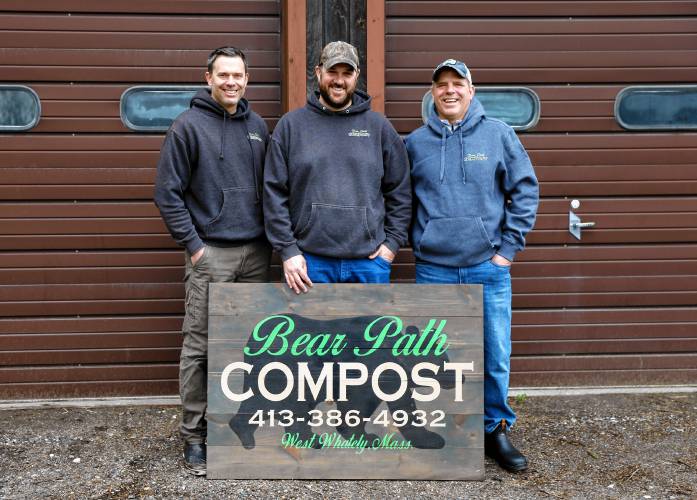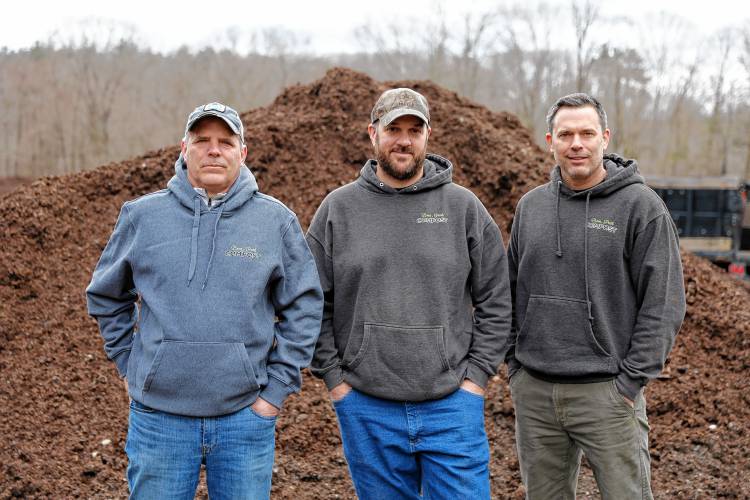Valley Bounty: Your soil will thank you: As garden season gets underway, Whately farm provides ‘black gold’ to many
| Published: 04-19-2024 11:13 AM |
“Compost is not soil, but it makes your soil better,” says Mike Mahar, owner of Bear Path Compost in Whately. “It adds life to it. If you’re going to take something out of the soil by harvesting, you should put something back in, and compost is perfect for that.”
Bear Path Compost takes waste materials from other farms and turns them into compost that’s certified for organic use. They sell to local farmers and landscapers, but most of their customers are home gardeners looking to give their plants a nutrient boost.
Mahar didn’t grow up in the compost business, but he did grow up next door to it. “Bill Obear, the previous owner of Bear Path Compost, was our neighbor,” he explains. “Since my brother Pete and I grew up on a dairy farm, we knew how to operate farm equipment, so he used to pay us a little cash to come help out.”
When Obear wanted to get out of the business, Mahar was a natural successor. The two ran things together for a year, then Mahar took over. All the while, Mahar never stopped raising cows. He and his brother still run Poplar Hill Farm on his family’s land, where instead of a dairy herd, they now raise beef cattle. This year he’s also taken on new business partners for Bear Path: Peter and Mark Melnik, who also own and operate Bar-Way Farm, a dairy farm in South Deerfield.
In the farm and garden world, compost is like WD40 or a flathead screwdriver — one simple tool that’s good for a lot of things. The main reason compost is so useful and versatile is its high amounts of organic matter, meaning materials that are or once were alive.
Most organic matter in compost is already decomposing, gently releasing nutrients back into the soil. Usually, this infusion of fertility isn’t as potent as adding fertilizer, but the nutrients stay in the soil longer and are less likely to wash away.
Compost also supports a rich community of soil organisms, the benefits of which include better soil structure, nutrient cycling, and aeration, which allows plants to root deep and still give their roots access to oxygen. Adding compost also helps the soil absorb more water and release it more slowly. In dry years, this sponge effect helps farmers and gardeners water more efficiently. In wet years, more absorption capacity means less soil erosion or drowned roots.
As a soil amendment for farm and garden beds, Mahar suggests a baseline mix of one part compost to three parts soil. Compost can also be spread as topdressing on lawns or garden beds for an added nutrient boost, and it can even be used as mulch.
Article continues after...
Yesterday's Most Read Articles
 A Waterfront revival: Two years after buying closed tavern, Holyoke couple set to open new event venue
A Waterfront revival: Two years after buying closed tavern, Holyoke couple set to open new event venue
 Island superintendent picked to lead Amherst-Pelham region schools
Island superintendent picked to lead Amherst-Pelham region schools
 Music key to Northampton’s downtown revival: State’s top economic development leader tours city
Music key to Northampton’s downtown revival: State’s top economic development leader tours city
 Pro-Palestinian encampment disperses at UMass, but protests continue
Pro-Palestinian encampment disperses at UMass, but protests continue
 Area property deed transfers, May 2
Area property deed transfers, May 2
 Amherst council hears call to scale back Jones work
Amherst council hears call to scale back Jones work
“Bark mulch is a better weed suppressor than compost, but as microbes break it down, they use up nitrogen,” Mahar explains. “Basically, bark mulch robs your garden of nutrients, whereas compost mulches and adds them back. We’ve started selling blends of bark mulch and compost, which allow you to have the best of both worlds.”
Mulch and compost mixes of 3:1 or 1:1 are available now. Starting soon, Bear Path Compost will also offer loam and compost blends in the same proportions.
At the most basic level, compost is made by mixing high nitrogen materials with high carbon materials and ensuring there’s enough moisture and oxygen for the composting process to occur. For high nitrogen ingredients, Bear Path mostly uses manure from the Melnik’s cows at Bar-Way Farm. For high carbon ingredients, they turn to spent shavings from horse shows at the Three County Fairgrounds in Northampton.
“Bar-Way manure is a natural fit (because of the Melnik’s involvement), and the fairgrounds generates a tremendous amount of bedding,” says Mahar. “Both work great for us because they’re very clean — hardly any trash or other contamination.”
Technically, it’s microbes that transform the mixture into finished compost. The farmer’s job is to create conditions where these microbes thrive. Getting the ratio of nitrogen to carbon is important, as is aerating piles, which they do by turning them by tractor every few weeks.
One sign of composting success is heat, generated by microbial activity, which speeds up decomposition and denatures most pathogens. As an added precaution, Bear Path also adds high carbon wood ash to bind and neutralize anything not denatured by the heat. After about nine months of turning, they’re ready to call it compost.
On average, Bear Path makes almost 3,000 cubic yards per year — about the volume of an Olympic sized swimming pool. They sell it by the cubic yard ($70 each) and other increments as small as a five-gallon bucket ($3.50 each).
“Since so many of our customers are home gardeners, we probably sell 100 to 150 yards through five-gallon buckets,” says Mahar. “That is a lot of five-gallon buckets.”
When buying compost, Mahar encourages customers to first use the calculator on their website, which shows how many cubic yards are needed for their project. From there, anyone buying smaller amounts can come fill their own buckets any time at Bear Path’s facility at 134 Webber Road in Whatley. From 9 a.m. to 12 p.m. on Saturdays, anyone purchasing larger amounts can also have their trucks and trailers loaded up free of charge, or they can call to request another pick up time. Bear Path will also deliver any order, no matter how small. The delivery fee is hourly, based on travel time.
Bear Path Compost’s address, contact details, prices, and self-serve instructions are all available on their website: bearpathcompost.com. Their website also has a considerable amount of information on the science and uses of compost, in general and for their products specifically.
Typically, Bear Path runs out of finished compost by mid-June as most farmers and gardeners move from prep to plant care. Until then, they are a source of “black gold” for many a green thumb around the Valley.
Jacob Nelson is communications coordinator for CISA (Community Involved in Sustaining Agriculture). As the growing season begins, visit buylocalfood.org to learn more about local farms and garden centers near you.










 Speaking of Nature: Bird of my dreams, it’s you: Spotting a White-tailed Tropicbird on our cruise in Bermuda
Speaking of Nature: Bird of my dreams, it’s you: Spotting a White-tailed Tropicbird on our cruise in Bermuda The Iron Horse rides again: The storied Northampton club will reopen at last, May 15
The Iron Horse rides again: The storied Northampton club will reopen at last, May 15 The power of poetry: U.S. Poet Laureate Ada Limón to speak at Smith College
The power of poetry: U.S. Poet Laureate Ada Limón to speak at Smith College Upon Nancy’s Floor: 33 Hawley event celebrates iconic dancers, history, and a new dance floor
Upon Nancy’s Floor: 33 Hawley event celebrates iconic dancers, history, and a new dance floor
